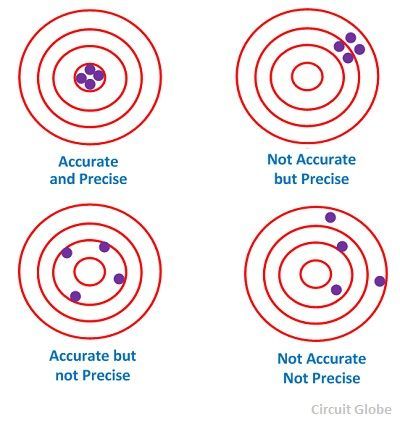Accuracy
Definition: Accuracy is the ability of the instrument to measure the accurate value. In other words, it is the closeness of the measured value to a standard or true value. The accuracy can be obtained by taking the small readings. The small reading reduces the error of the calculation. The accuracy of the system is classified in the following ways.
1. Point Accuracy – Point accuracy means the accuracy of the instrument is only at the particular point on its scale. This accuracy does not give any information about the general accuracy of the instrument.
2. Accuracy as Percentage of Scale Range – The uniform scale range determines the accuracy of the instrument. This can be easily be understood by the help of the example shown below.
Consider the thermometer having the range up to 500ºC. The accuracy of the thermometer is considered up to ±0.5, i.e. ±0.5 percent increases or decrease in the value of the instrument is negligible. But if the reading is more or less than 0.5ºC, it is considered the high-value error.
3. Accuracy as Percentage of True Value – Such type of accuracy of the instruments is determined by identifying the measured value regarding their true value. The accuracy of the instruments is neglected up to ±0.5 percent from the true value.
 Precision
Precision
Definition: The term precision means two or more values of the measurements are closed to each other. The value of precision differs because of the observational error. The precision is used for finding the consistency or reproducibility of the measurement. The conformity and the number of significant figures are the characteristics of the precision.
The high precision means the result of the measurements are consistent or the repeated values of the reading are obtained. The low precision means the value of the measurement varies. But it is not necessary that the highly precise reading gives the accurate result.
Example – Consider the 100V, 101V, 102V, 103V and 105V are the different readings of the voltages taken by the voltmeter. The readings are nearly close to each other. They are not exactly same because of the error. But as the reading are close to each other then we say that the readings are precise.

Very nice. I understood everything.
Good job!
👌👌
👍👍👍 good job